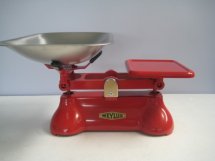Balance scales kitchen

A basic understanding of the principles of interior design will help you make the most of your space when planning your new kitchen. While design elements are the basic components or tools you work with, principles guide the use of those elements. This discussion of design principles is general, not limited to kitchen cabinet layouts. Kitchen design components include cabinets, appliances, colors, backsplash, countertops, flooring and decorative items. How they work together to provide a beautiful and functional kitchen depends on the principles of interior design: balance, emphasis, proportion and scale.
Visual Balance in the Kitchen
Balance, the most important principle in interior design, refers to the visual equilibrium in the design of a room. A well-balanced room communicates a sense of relaxation and security. This is achieved by placing objects according to their visual weight. An object’s visual weight is its ability to draw attention to itself and is determined by its line, form, color, and texture elements. Darker shades, bright colors, and strong textures lead to a heavy weight. In contrast, cooler shades, subtle textures, and reflective surfaces give an object less visual weight. To maintain balance, try to distribute the elements equally throughout the room. Formal balance, often referred to as symmetrical balance, creates a mirrored-image effect from the center of the room. On the other hand, informal balance uses different objects of the same visual weight to create equilibrium in a room. It is more subtle and spontaneous and gives a warmer, more casual feeling.
In this Dayton kitchen, windows, wall cabinets and island are balanced and complemented by pendant lights
This Austin kitchen balances upper wall cabinets with glass doors
The Dayton kitchen uses simple lines with wall and base cabinets in a narrow space
The Dayton kitchen demonstrates a kind of symmetry as the drawer base cabinets flank the cook-top area.
Emphasis
Emphasis is expressed through focal points, objects that immediately draw your attention as you enter a room. A focal point in a kitchen may be a sink, stove or cooktop area, center island, furniture-look hutch, buffet or bar, a window that frames a beautiful view, or a piece of artwork displayed in a glass door cabinet. Other objects in the room must support, not compete with, the decided focal point. A large space may have more than one focal point. You can add emphasis by highlighting a natural focal point or create one through the use of line, form, color and texture.
Related posts:

 One of the more cost-effective measurements in a paper mill is that which monitors the flow of pulp stock into the head box of the paper machine. The stock level…
One of the more cost-effective measurements in a paper mill is that which monitors the flow of pulp stock into the head box of the paper machine. The stock level… Overview Marel Marine Scales are specifically designed for use on board fishing vessels and factory trawlers. This cost-effective series of scales ranges from the…
Overview Marel Marine Scales are specifically designed for use on board fishing vessels and factory trawlers. This cost-effective series of scales ranges from the… How long to air fry french fries what does fafsa stand for What does it mean when ypu use alocohol and the tips of your fingers turn white Who raps bitches aint…
How long to air fry french fries what does fafsa stand for What does it mean when ypu use alocohol and the tips of your fingers turn white Who raps bitches aint… Globe s portion control scales can be used in a wide spectrum of applications from delis and pizza parlors, to bakeries and restaurants, or any establishment where…
Globe s portion control scales can be used in a wide spectrum of applications from delis and pizza parlors, to bakeries and restaurants, or any establishment where… How to get bubbles out of screen protector? Totally add add tips and tricks how to eat an elephant list What are all the tricks you can have in trickerion board…
How to get bubbles out of screen protector? Totally add add tips and tricks how to eat an elephant list What are all the tricks you can have in trickerion board…